|
On Wednesday August 11, 1999, a total eclipse of the Sun will be visible from within a narrow corridor which traverses the Eastern Hemisphere. The path of the Moon's umbral shadow begins in the Atlantic and crosses central Europe, the Middle East, and India where it ends at sunset in the Bay of Bengal. A partial eclipse will be seen within the much broader path of the Moon's penumbral shadow, which includes northeastern North America, all of Europe, northern Africa and the western half of Asia. One of the rare places with a total solar eclipse is Munich, Germany, where I live.
The Sky During Totality
During totality, a number of bright planets and stars will be visible. Venus (m=Ð3.5) will be the most conspicuous planet located 15° east of the Sun. Mercury (m=+0.7) should also be visible 18° west of the Sun. The southwestern sky will be dominated by the bright stars of winter, including Capella (m=+0.08), Albebaran (m=+0.85v), Procyon (+0.38), Betelgeuse(+0.5v), and Sirius (m=-1.46). Other bright stars which may also be visible include Spica (m=+1.0v), Arcturus (m=-0.04), and Regulus (m=+1.35).
What to Expect
First of all a word of safetly, Never look at the Sun without proper eye protection! Sunlight will result in eye damage or blindness. There is safe ways to watch the sun. For over an hour before the total eclipse, the edge of the Moon gradually covers the solar disk. "First Contact" happens when the edge of the Moon first intrudes on the Sun. From three minutes to one minute before a totality, only a thin crescent-shaped sliver of the Sun remains. The landscape appears darker than usual. If atmospheric conditions are right, "Shadow Bands" will appears like the occurrence of sunlight under the swimming pool. This effect causes by atmospheric phenomenon.
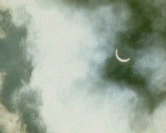 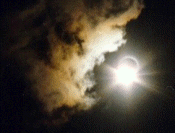
From deep partial phase to the Diamond Ring Effect
About a minute before total eclipse begins, a necklace of brilliant points, causes by mountain peaks along the Moon's edge, will occurs. The English astronomer Francis Baily first described the phenomenon in 1876, its called "Baily's Bead". During the last 15 seconds, often one bead shines more brightly than the other to give what called "Diamond Ring Effect" and western sky darkens. The last beads then disappear, marking the beginning of totality, called "Second Contact".
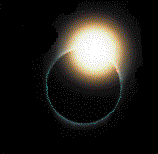 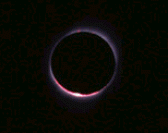
Just before 2nd contact and Chromosphere
During totality, the Moon completely masks the Sun and the sky is about as dark as twilight. Bright stars and planets appearing in the darkened sky now. A total eclipse brings into view the Sun's "Corona", a white structured halo of light extending for a distance of a few lunar diameters. In addition, a red layers, called "Chromosphere", remains visible. "Prominences", which is a red flame-liked extensions may be appear during totality.
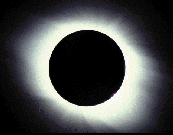
Outer Corona
Generally, duration of totality can last anything from a few seconds up to 7 1/2 minutes. Maximum duration for total eclipse in 1998 and 1999 are 4.1 min. and 2.4 min. respectively. Then the flash of Diamond Ring and Baily's beads occur again, marking the " Third Contact ", announcing that the total eclipse is over. Now, the Moon moves off the phase of the Sun. "Last Contact" will takes place when the partial phase of the Sun is end. All phenomenons during a complete event of total solar eclipse is about three hours from first contact to last contact.
Eclipse Photography
Very interesting eclipse photographs can be taken with ordinary cameras having standard focal lengths, particularly at totality. Techniques for photographing the solar eclipse are different from another celestial objects. Because of variation of brightness of the Sun during partial phase to totality, unless a camera, film, tripod, suitable filter also important thing to prevent damages of your equipment and your eyes especially.
Camera and Lens
SLR (Single Lens Reflex) camera is a better than compact camera to capture the eclipsed Sun. Adjustable lens and f/number can be used for any type of events. However, you might use a compact camera to photographs exciting people, crescent Sun under a leafy tree, reaction of animals or birds, sky during totality, and anything you want but remember that do not aim the camera to the Sun directly without optical aids (solar filter).
Important factor is a focal length of a camera. Standard camera has a focal length equal 50mm that produces 0.5mm image of film. To show the Sun's disk reasonably large, you need a lens or telescope with a longer than 500 mm in focal length. Tripod and cable release also need for this case of lens. To calculate diameter of the Sun on film, divide the focal length into 109. At higher magnifications, blurriness due to the Sun's motion might be a problem. To calculate the longest exposure possible before blurriness occurs, divide the telescope or telephoto's focal length into 250. If you don't have a long focal length lens, 2X and 3X teleconverter is a possibly choice.
Film
Due to the Sun's brightness, we can select a low speed film (low ISO), which will be fine grain for this work. For solar eclipse, ISO 100 or 200 negative film or ISO 64 or 100 slide film are nice enough. However, fast film is better if very long focal length to reduce blurriness of the Sun's image.
Filter
During partial phase, you must use a mylar or glass filter over the front of the lens to reduce strong brightness of the Sun's surface and protect your eyes. Aluminized Mylar or metal on glass (metalized glass filter) are best filters to use.
Mylar-type filter will produces blue-gray solar disk, Metal-type filter will produces orange image. Neutral Density (ND filter) also a good filter but beware to use because it can not reduce ultraviolet and infrared completely. Finally, don't forget to remove the solar filter when totality begins! it is completely safe to look at a totality eclipsed Sun, even with a telescope or binoculars. However, prepare to use the filter again when diamond ring effect occurs, that means the end of totality is coming.
Time Schedule for Munich
NB! All times are UTC, you need to add 2 hours for Central Europe.
The eclipse will start at 09:16:20 and total eclipse of the sun will happen at 10:38:16 it will last for 2 minutes and 8 seconds. To get the best view, take a look at the map here where you should be at the time. The schedule looks like this:
First contact, partial eclipse, begins 09:16:20
Second contact, total eclipse begins 10:38:16
Third contact, total eclipse ends 10:40:24
Forth contact, partial eclipse ends 12:01:25
Local Circumstances for Sweden
Sweden is my home country so I will pay some attention to what happens back home. Unfortunately, there wont be a total solar eclipse in Sweden until year 2116, so this partial eclipse is what we have to settle with for a few more years. In Stockholm the sky will look like this.
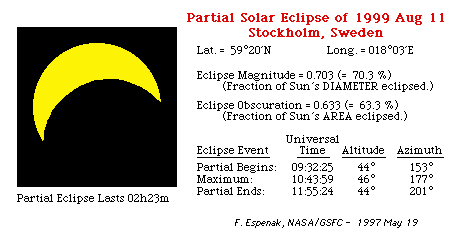
View from Stockholm
For the rest of the country, detail information can be found in this table. It includes the cities of Borås, Göteborg, Helsingborg, Jönköping, Linköping, Malmö, Norrköping, Örebro, Stockholm, Uppsala and Västerås.

|
















